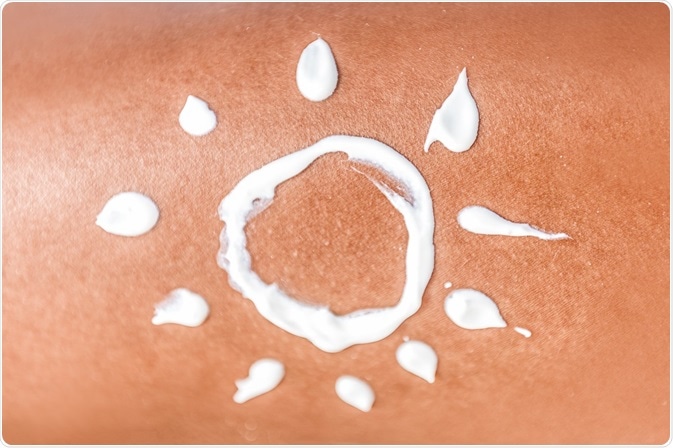Keratoacanthoma is a benign skin cancer characterized by small dome-like bumps on the surface of the skin.
 Credit: Maridav/Shutterstock.com
Credit: Maridav/Shutterstock.com
Keratoacanthoma originates in the hair follicle and is not known to spread. It is very similar to the Squamous Cell Carcinoma (SCC). However, this is a much more aggressive type of skin cancer that can cause considerable disfigurement.
The skin lesions experience rapid growth in the initial few weeks, then the Keratoacanthomas seem to go dormant for a while. After 4 to 6 months the skin lesions will begin to spontaneously resolve. It has been identified as a nonmelanoma skin cancer that originates in the pilosebaceous glands. Some dermatologists also classify it as a Squamous cell carcinoma of the Keratoacanthoma type.
Who is at risk for developing keratoacanthoma?
Keratoacanthoma is most commonly found in individuals who have skin damage resulting from frequent exposure to solar radiation (UV). Keratoacanthoma outbursts are commonly found on the UV exposed parts of the skin such as the face, neck, hands, arms and legs. Keratoacanthoma is less commonly seen on the torso, which is often better protected from sun damage.
Multiple Keratoacanthomas have been studied and found to run in families. The older generation is at more of a risk compared to younger people. Most cases recorded are of individuals in their sixties and older. Caucasians are more likely to develop Keratoacanthoma than those with darker complexions. There may be a genetic connection as individuals whose family members develop Keratoacanthoma, are more at risk of developing it themselves, however, there is no conclusive evidence to support this hypothesis.
Individuals who have regular contact with chemical carcinogens are more at risk of developing the skin condition. As are those individuals who smoke, and are suffering from a lowered immune system due to a previous illness. Patients of trauma such as accidents, as well as organ transplantation, are both more vulnerable to developing Keratoacanthoma. Frequent users of tanning beds and those individuals who have naturally fair skin, again face a higher risk.
How can keratoacanthoma be prevented?
Since frequent exposure to the sun is the most common cause of Keratoacanthoma, prevention involves protecting the skin from sun damage. This can be done by staying out of the sun, especially when the sun’s radiation is strongest at midday, applying a heavy sunscreen with an SPF of 30 or more, and wearing full-sleeved clothing while outdoors. Artificial ultraviolet radiation, such as that used in tanning beds, should also be avoided.
The individuals who develop Keratoacanthoma once, are at high risk of the skin condition reoccurring. If a family member has suffered from Kerantoacanthoma, it increases the individual’s risk of developing the neoplasm. The high-risk group should be taught to examine their skin on a regular basis for new moles, colored patches on the skin, or any unusual bumps. Not all bumps may be a reason for concern, but it is better to be sure by showing it to a dermatologist.
The sooner that a skin lesion is spotted, the faster it can be brought to the attention of a dermatologist for diagnosis and treatment. By ignoring a skin condition many individuals have ended up with severe complications which could have been easily avoided by early detection and treatment. Given the increasing numbers of skin cancer being reported worldwide, a bit of precaution is advisable.
Diagnosis and treatment of keratoacanthoma
Keratoacanthomas can spontaneously heal after a period of time. However, since the skin lesions closely resemble Squamous Cell Carcinoma, a dermatologist will recommend getting the lesion diagnosed. Only a biopsy of the tissue will reveal for certain if it is a Keratoacanthoma or Squamous Cell Carcinoma. This is how the diagnosis is confirmed.
Removal of the skin lesion is considered a full cure of Keratoacanthoma. In case the individual goes in for a biopsy, the skin lesion is entirely removed and treatment is considered complete. The skin lesion may be removed by one of these three methods – cryotherapy, excision, and curettage or cautery. The dermatologist must ensure that none of the affected tissue is left behind during the removal procedure.
The prognosis for Keratoacanthoma is excellent post-surgery. However, treatment does leave a scar on the skin once it is healed. There is less than a 20% chance of a Keratoacanthoma spreading to another location.
Most individuals will not have a second skin lesion, but in rare cases, multiple skin lesions have also been recorded. Multiple Keratoacanthomas are often a symptom of another underlying illness and must be shown to a health care provider.
Sources:
- http://www.dovemed.com/diseases-conditions/keratoacanthoma/
- https://patient.info/doctor/keratoacanthoma-pro
- http://www.aocd.org/?page=Keratoacanthoma
- https://www.dermnetnz.org/topics/keratoacanthoma/
- https://emedicine.medscape.com/article/1100471-overview
- https://www.healthline.com/health/keratoacanthoma#outlook8
Further Reading
Last Updated: Apr 6, 2021